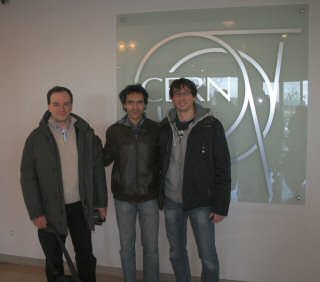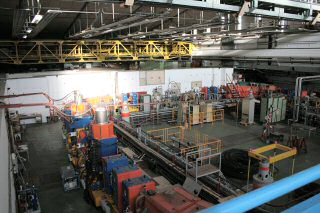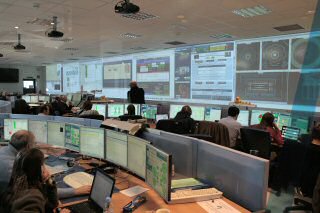
On December 8th, a holiday in Italy, we woke up early in Geneva to visit the CERN centre. After a rainy day spent visiting Geneva, the Moon was shining in the sky, telling us that beside some remaining clouds, it was going to be a sunny day. The CERN laboratories are nearby Geneva airport, just outside the city, and if it was not for some roadworks that forced us to find alternative paths playing with the GPS – finally we arrived in front of Building 33, the CERN reception. Outside, on the other side of the road, the Globe of Research and Innovation marks the spot, telling this is not just the usual campus.
Our booked visit was beginning at 10, but my colleague Dario happen to be friend of a physicist working there, thereby we were invited to have breakfast with him. While waiting for him we bought some souvenirs of the visit, including the helmets used while accessing the instruments.
We met Matteo, and he guided us along the labyrinthine corridors of CERN to the self-service area to have breakfast. The CERN is a small, cosmopolitan citadel, people coming from all Europe and beyond.
We spent breakfast discussing Matteo’s work – a study on how to predict how instruments become radioactive with use, and thereby how to dispose of them correctly. Although CERN is the place where the World Wide Web was born, we were more interested in its main research area, particle physics. I studied Physics at the university, and although later turned to IT, I always kept a strong interest in Physics.

Then we had an “unofficial” visit, showing us the main Auditorium – it’s here where Rubbia announced the W and Z bosons discovery, and after a brief walk along the campus – each street named after a scientist, one to Babbage too – he showed us the machine used to create antimatter, the Low Energy Antiproton Ring, now being converted as the Low Energy Ion Ring to prepare and inject lead ions into the LHC ring. It was impossible to get close to the machine because the area is radioactive and it requires a permission and a dosimeter – next time maybe… 😉
After an interesting discussion about how the LHC was designed and built – and how superconductive magnets resolve many of the issues that plain magnets have at the power required to achieve the energy the LHC reaches, and how to cool them to obtain the superconductive effect (we have to wait for superconductive processors…), we returned to the reception to start the official visit.
Here we were met by a scientist volunteering to show the CERN to visitors. Visits are not always the same, because what can be see depends on the actual activity, and of course the LHC is off-limits because of its delicacy – if small birds can stop it, think about a school!
First we were shown a movie introducing the CERN, its history and what kind of researches it is capable of. Then we moved to the building where the ATLAS detector is hosted 100 metres below surface. ATLAS is one of the detectors placed along the LHC ring, and one of the main instruments that should shed light on why particles have a given mass (by creating and studying the Higgs boson), Dark Matter and if there are other dimensions beyond the four we know.
Although studying the “invisible”, ATLAS is a large instrument, as heavy as a WWII destroyer, and is placed at the end of a large well – the building of the detector itself posed a large number of technical issues to solve, and after an explanation of the sensors it uses and the different technologies used to read both particles direction, momentum and energy, another movie, this time in 3D, showed how the ATLAS was built. Then we moved to building covering the ATLAS well, where some sample of the detector sensors where exhibited. Our scientist explained how they are used, and what they expect to find.

We returned to the ATLAS control building, where a large transparent wall allows visitors to look at the instrument control room. At the time of our visit they where preparing the first 2.36 TeV collision ever, which occurred later that day. One of the interesting IT aspects of such detectors is the large amount of information they produce. The system must be able to identify the interesting events where quickly and store the data, while discarding the non interesting ones
A Delphi developer can not avoid to note there was no Windows computers there: just Linux and Apples (and then scientist says their are paid little…) all around. Would Delphi X make a breach there?
An interesting Q&A session in front of the control room ended the visit. We returned to the reception where the entrance of the Microcosm museum is. The museum displays some interactive experiments to show basic particle physics discoveries, and some older and now “historic” machines, as the large projector used to study reaction on films, and older accelerators and detectors no longer in use, as the old linear accelerator and parts of the LEP which lead to the W and Z discovery.

There’s also, for the IT guys, a room dedicated to the hardware that helped physicists to handle the data that started to emerge from more and more sophisticated detectors, from some very old IBM machines to one of the very first Cisco routers, to the NeXT computer where the World Wide Web was developed and then escaped to make rich some guys using it for Facebook instead of exchanging data about esoteric theories about how our Universe is really made.
Well, our time was over, and it was time to decay back to our older lives, where electrons happily runs in processor and wires and magnetic fields store data in disk plates – and quarks, mesons and other particles are not coffee machine conversations topics.
Photos courtesy of and copyright © 2009 Dario Luinetti. All rights reserved.
